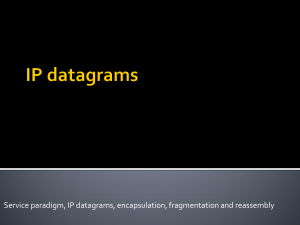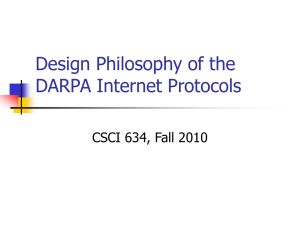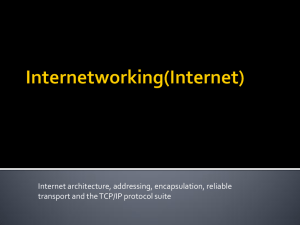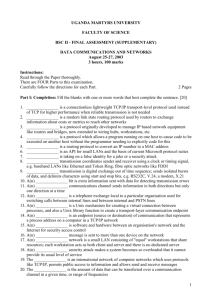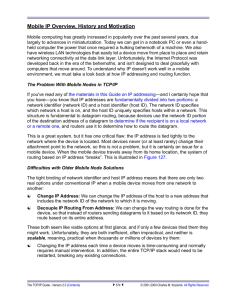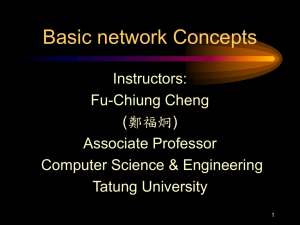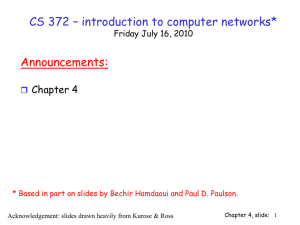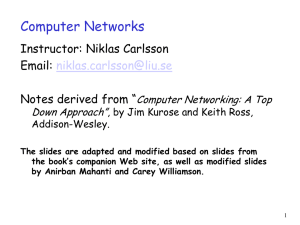Internet Protocol, IP Addressing and Datagrams
advertisement
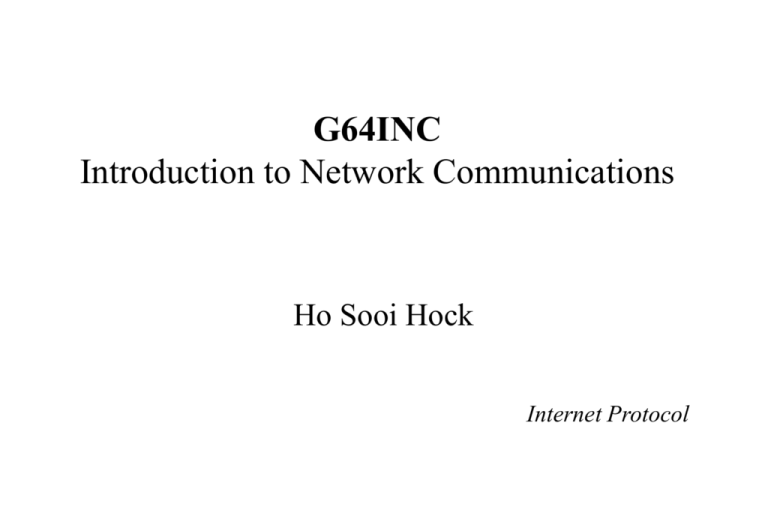
G64INC Introduction to Network Communications Ho Sooi Hock Internet Protocol Outline • • • • • • Internetworking IP Addressing Hierarchy Classful vs. Classless Addressing Special IP Addresses IP Datagrams Fragmentation Internetworking • Existence of multiple network technologies today • A need to interconnect heterogeneous networks to form single internet – hardware: routers connect different physical networks – protocol software: give the illusion that there is a single virtual (logical) network providing universal service Internetworking Protocols • The TCP/IP Reference Model – begun in the 1970s – the Internet has emerged into the public domain in the 1990s – controlled by the Internet Engineering Task Force (IETF) • TCP/IP used the term host computer to refer to any system that connects to an Internet running applications • Both hosts and routers use TCP/IP protocol software Internet Reference Model Directed Reading • Open Systems Interconnect Reference Model (OSIRM) – Chapter 1: Introduction and Overview 1.6 to 1.9 Message Transmission Example Position of IP in TCP/IP Protocol Suite The IP Address Hierarchy • Every host is assigned a globally unique 32-bit address for identification • Each 32-bit address is divided into two distinct parts – prefix: physical network to which a host is attached, also known as network number – suffix: a host attached to a given physical network, also known as host number • Prefixes are coordinated globally and suffixes locally. Hence the former is unique but the latter can be duplicated Classes of IP Address • Size of prefix and suffix determines maximum number of networks and maximum number of hosts per network respectively • IP defines different classes of address with different sized prefixes and suffixes • The first four bits of the address specify the address class The Five Classes of IP Address Division of the Address Space • Public Internet network numbers are assigned by Internet Service Providers (ISPs) and these are coordinated by the Internet Assigned Number Authority Default Masks for Classful Addressing An Addressing Example Routers and IP Addressing • Routers are assigned two or more IP addresses • So are multi-homed computers Special IP Addresses Example of this host on this address Network Addresses Example of Direct Broadcast Address Example of Limited Broadcast Address Example of Loopback Address CIDR Notation • A large part of available addresses were wasted due to the use of classful addresses • Classless addressing, known as CIDR (Classless Interdomain Routing) was adopted • Network suffix can be any number of bits long, rather being constrained to 8, 16 or 24 bits • CIDRized network address has the dotted decimal form a.b.c.d/x. • x defines the number of mask bits and a.b.c.d is the first address in the block (by setting 32-x bits to 0s) • More efficient allocation of IP addresses IP Datagrams • Data are transmitted in small units called packets, with header added containing control information, e.g. addresses, data length etc. • Internet protocols define a universal virtual packet – the IP datagram • IP datagrams are switched across multiple physical networks via routers • IP datagram can be at most 64K octets, including header and data IP Datagram Header Format • TTL field used to prevent looping datagrams and used for tracing routes Protocol Field and Encapsulated Data Examples of Protocol Values Routers and Routing Tables • Each router forwards IP datagrams by matching the destination IP address of the IP header to entries in a local routing table • Each entry consists of: – destination address – subnet mask 32 bit value that specifies the boundary between network prefix and suffix – next hop IP address of a router or hardware interface that allows direct delivery Example Routing Table Binding Protocol Addresses • An Internet packet passes through a series of routers – each hop takes it over a particular network, either to a specific computer on that network or to the next router – in either case, the sending host or router has to map between the protocol (IP) address and a hardware address – this is known as address resolution Address Resolution Protocol • TCP/IP defines the Address Resolution Protocol (ARP) which defines the format of resolution requests and responses • This technique is usually combined with local caching of hardware addresses Frame Encapsulation • Protocols – TCP – end to end, identification by port numbers – IP – host to host, identification by IP addresses – Network Interface (Link Layer) – hop to hop (link to link), identification by MAC addresses MTU and Datagram Size • Maximum Transmission Unit – maximum-sized packet that can be carried on a given physical network • IP datagrams may have to cope with different MTU sizes as it passes over an internet Fragmentation • A datagram that is larger than MTU will be fragmented into smaller fragments • Each datagram contains a fragment • Header fields indicate when the data is a fragment and also where it belongs MTUs for Some Networks – identification, flags and fragment offset Fragmentation Example • Reassembly done at the final host only – routers require less state information – fragments can take different routes • Whole datagram is lost if any fragment lost Best Effort Delivery • Connectionless Service • IP attempts best effort delivery and does not guarantee to deal with: – – – – datagram duplication delayed or out of order delivery corruption of data datagram loss • These issues are dealt with by the next higher transport protocol i.e., TCP (Transmission Control Protocol) Acknowledgements Most lecture slides used in this presentation are adopted from the same module taught in Nottingham, UK Campus, with addition of diagrams from the recommended texts by Douglas E. Comer and A. Forouzan.
